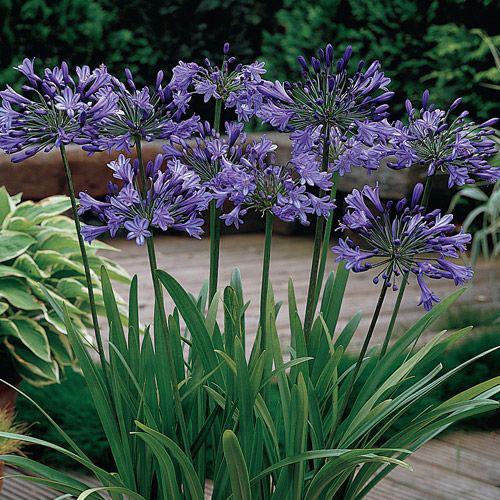Understanding the Art of Agapanthus Care: Essential Actions for Healthy Development and Lively Flowers
In the world of horticulture, the cultivation of agapanthus stands as a fulfilling endeavor for those that seek to nurture these sophisticated blooming plants. From selecting the best variety to understanding pruning techniques, the trip in the direction of cultivating flourishing agapanthus plants is complex and holds the crucial to unlocking the full capacity of these herb gems.

Picking the Right Agapanthus Variety

When selecting the appropriate Agapanthus variety for your yard, consider variables such as climate suitability, blossom color, and growth practice. Agapanthus, frequently referred to as Lily of the Nile or African lily, comes in a selection of shades ranging from shades of purple and blue to white. Select a bloom shade that enhances your existing garden palette to produce an unified landscape. Additionally, think about the climate in your area to make certain the Agapanthus selection you choose can grow in your specific problems. Some selections are extra forgiving of chilly temperatures, while others like warmer environments. Comprehending the growth habit of various Agapanthus selections is critical for appropriate placement within your yard. Some ranges have a clumping growth habit, perfect for boundaries or containers, while others have an even more spreading nature, ideal for ground cover or mass plantings. By thoroughly evaluating these elements, you can pick the perfect Agapanthus selection to improve the beauty of your yard.
Perfect Growing Conditions
Taking into consideration the optimal ecological demands is important for successful Agapanthus cultivation. Agapanthus prospers in well-draining dirt with a slightly acidic to neutral pH degree. When planting, pick a location that gets complete sunlight to partial shade. In hotter climates, providing some afternoon color can stop scorching of the fallen leaves. Agapanthus plants are delicate to cool temperature levels and should be secured from frost throughout winter season.
To ensure healthy and balanced development and vivid blossoms, plant Agapanthus light bulbs at a deepness of about 2-4 inches and room them 8-12 inches apart. Mulching around the base of the plants assists preserve dampness and subdues weed development.
Watering and Feeding Tips
Keeping appropriate moisture levels and giving essential nutrients are crucial components in the treatment routine for Agapanthus plants. When it comes to sprinkling Agapanthus, it is essential to strike an equilibrium. These plants like consistently damp dirt yet are prone to root rot if overwatered.
Feeding Agapanthus is necessary for promoting healthy growth and respected blooms. Apply a balanced fertilizer, such as a 10-10-10 YOURURL.com formula, in the early spring as brand-new development arises. By following these watering and feeding ideas, you can guarantee your Agapanthus plants thrive and produce lively, durable flowers.
Trimming Strategies for Agapanthus
Trimming Agapanthus plants at the appropriate times and with proper techniques is essential for keeping their health and wellness and advertising optimum development and blooming. The suitable time to prune Agapanthus is in late winter or very early spring prior to brand-new development emerges.
Deadheading invested blossoms can likewise reroute the plant's energy into generating more blossoms rather than setting seeds. If you desire to accumulate seeds for proliferation, leave some blossoms to fully grown and completely dry on the plant.
Bear in mind to make use of tidy, sharp devices to make specific cuts and minimize the threat of introducing illness. Agapanthus. Regular pruning will help maintain your Agapanthus looking cool and healthy while making sure a plentiful display of gorgeous blooms
Dealing With Typical Pests and Conditions
After making sure proper trimming methods original site for Agapanthus, it is necessary to resolve common pests and conditions that can influence the health and wellness and vigor of these plants. Agapanthus plants are typically durable but can still succumb to specific issues. One typical bug that impacts Agapanthus is the Agapanthus gall midget. This small, orange fly lays its eggs in the vegetation, causing altered growth and flower buds that fail to open up. To combat this bug, prune and destroy any kind of affected plant components and think about making use of insecticidal soap.
Furthermore, Agapanthus plants can suffer from root rot if they are planted in improperly draining pipes dirt. By being watchful and taking timely action versus pests and illness, you can aid your Agapanthus plants prosper and create lively blooms. Agapanthus.
:max_bytes(150000):strip_icc()/agapanthus-growing-guide-7368912_hero-a3585e4f9ffe4b99a73c7ad8eb4ebe48.jpg)
Conclusion
In conclusion, mastering the art of agapanthus care involves picking the best selection, giving perfect growing conditions, proper watering and fertilizing, ideal trimming techniques, and addressing usual bugs and illness. By complying with these necessary steps, you can make certain healthy growth and lively blooms for your agapanthus plants. Keep in mind to on a regular basis monitor and preserve your plants to promote their overall well-being and durability.
To make certain healthy growth and dynamic blossoms, plant Agapanthus bulbs at a depth of about 2-4 inches and space them 8-12 inches apart. By complying with these watering and fertilizing suggestions, you can ensure your Agapanthus plants content thrive and create lively, durable blooms.
One common insect that impacts Agapanthus is the Agapanthus gall midget. Furthermore, Agapanthus plants can endure from root rot if they are planted in badly draining pipes soil. By adhering to these vital actions, you can guarantee healthy development and dynamic blooms for your agapanthus plants.